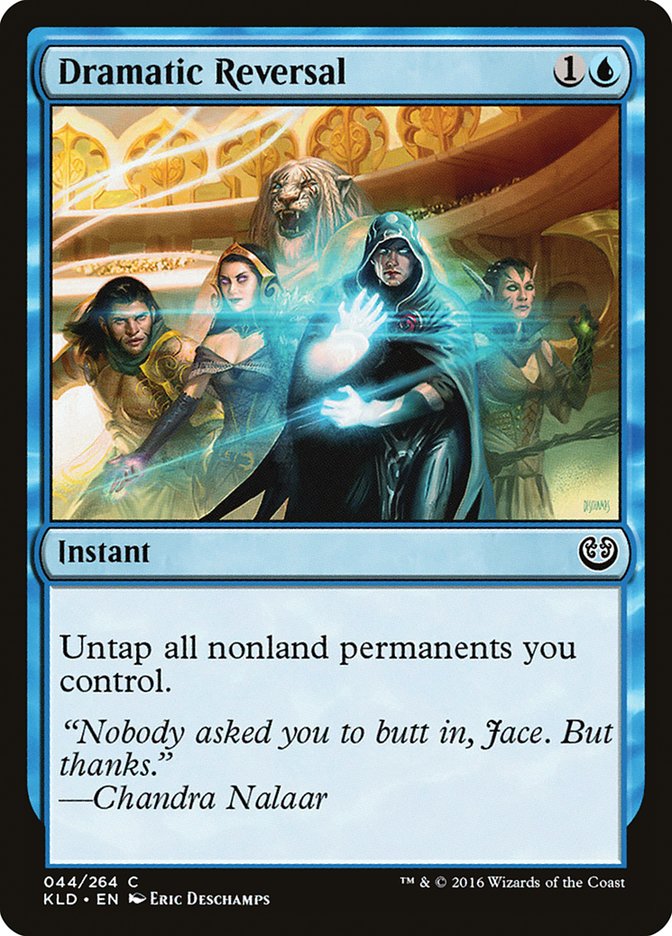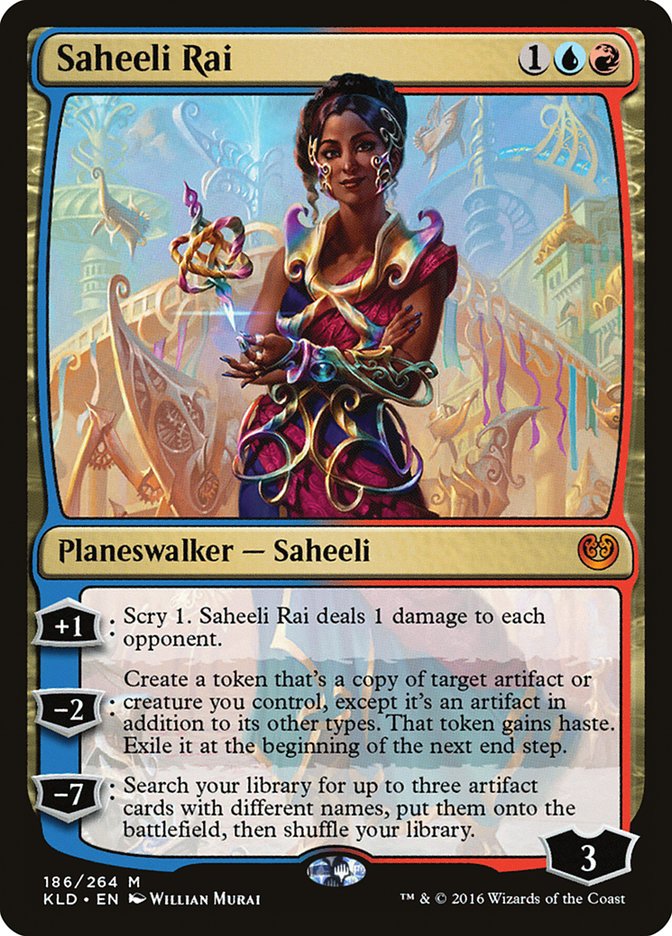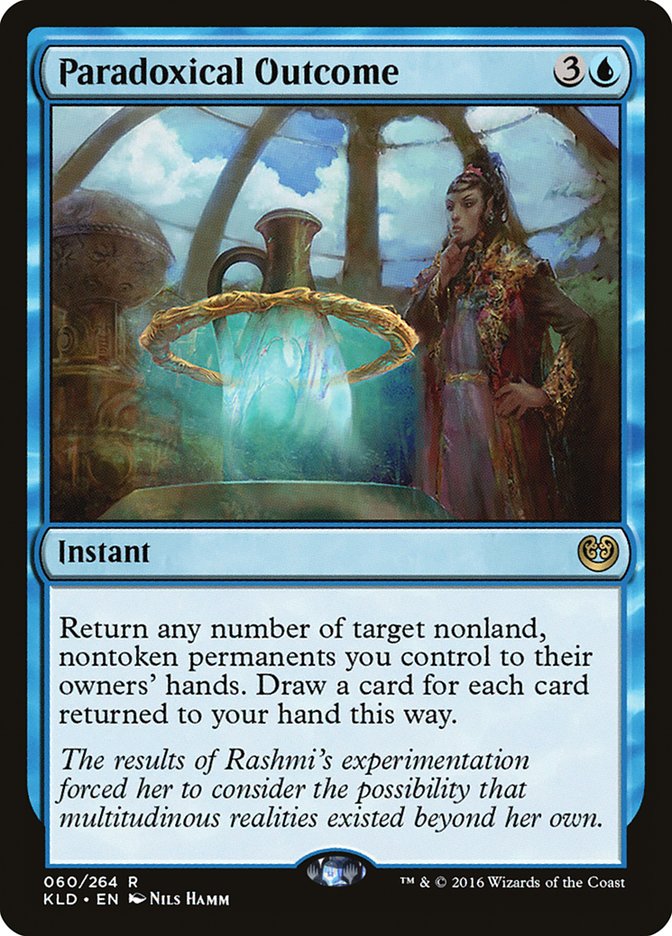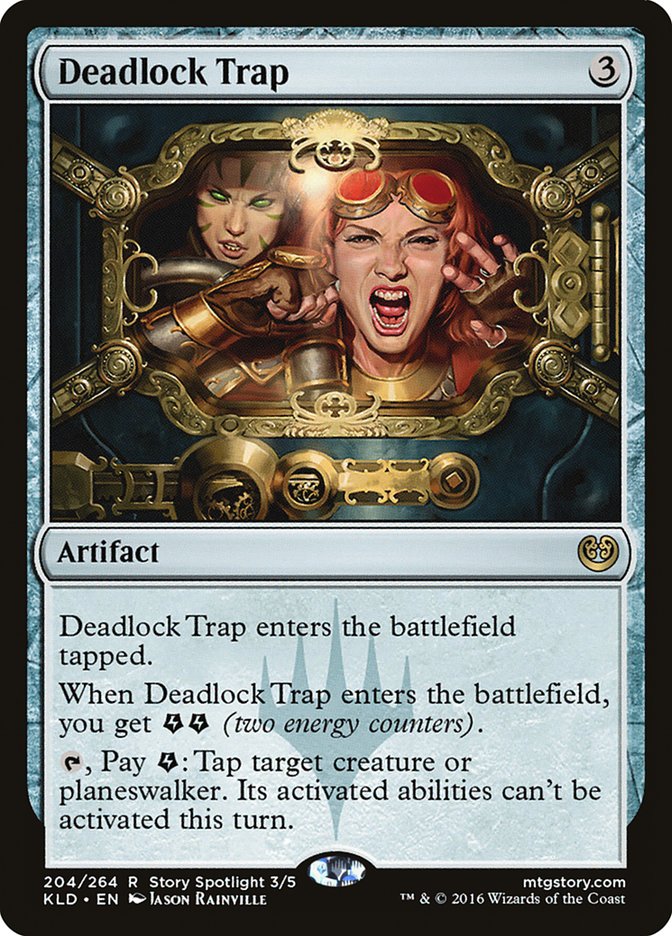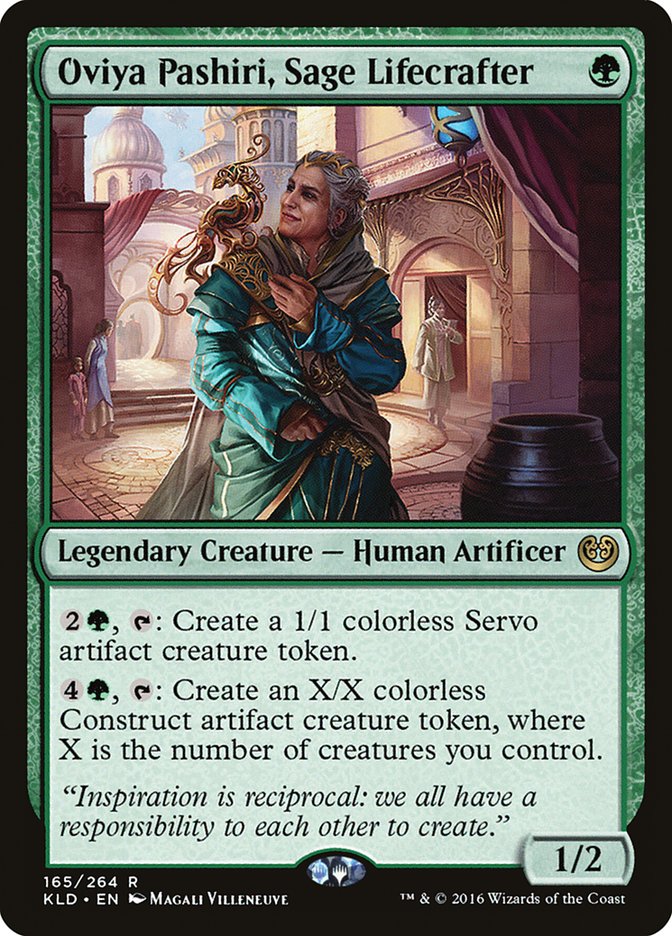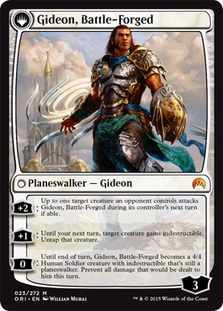The Kaladesh edition of Magic Story has been a roller coaster. Some installments have been compelling successes (in chronological order, “A Time for Innovation” by Kimberly J. Kreines, “Born of Aether” by Alison Luhrs, and “Release” by Chris L’Etoile are my top three); others have moved the main storyline along serviceably or clunked.
Between the highs and the lows, a clear trend has emerged. The Gatewatch (Gideon Jura, Jace Beleren, Liliana Vess, Chandra Nalaar, and Nissa Revane) are considered the main characters of Magic, with Jace the “Mickey Mouse of Magic” and Gideon showing up as Wizards of the Coast’s “Magic Representative” on some of parent company Hasbro’s properties (though Jace still has the corporate fact sheet on lockdown). One Gatewatch member or another has shown up in most of the tales.
And in the stories that have worked best, non-Gatewatch characters have taken center stage.
Why would Tamiyo, Ajani, and non-planeswalkers like the retired Aetherborn tycoon Yahenni and the war-refugee rat-child Nashi be so much more compelling than the main faces of Magic? I believe the answer lies at the intersection of Magic’s color wheel and the literary world’s concepts of flat and round characters.
Round and Round
The notion of flat and round characters has been around a lot longer than E.M. Forster‘s codification of it in his 1927 lectures-turned-book, Aspects of the Novel, but the terms themselves are useful.
Broadly speaking, a flat character doesn’t change much during a story. That’s not to say their lives may not change dramatically; just ask Rosencrantz and Guildenstern, or any redshirt who goes from living to dead to put the fear in a main character. Their beliefs and views, however — really, anything that makes them themselves — will stay roughly the same. In Arthur Miller‘s play The Price, for example, Esther Franz exists only to be Victor Franz’s wife and an alcoholic, a sign of the wrong turns Victor’s life has taken. All the brother-against-brother drama doesn’t touch her, and effectively the same character walks offstage for the last time as walks onstage the first. She’s as flat as the Paper Tiger below that’ll act as a spoiler buffer before I go any further.
By contrast, Gregory Solomon, the elderly antiques dealer, is a round character. Summoned out of retirement by a listing in an old phone book, at first he doesn’t want to buy anything out of the cluttered apartment. But as the play unfolds and the policeman-brother and doctor-brother go at each other, Mr. Solomon’s perspective changes. At the end, with newfound determination to do something with the time he has left, Mr. Solomon makes an offer for the whole lot, shedding past sorrows and throwing himself back into the trade.
It is this shift in attitude that makes him round. Arguably Gregory Solomon is the only round character in The Price, as the brothers do a lot of squawking but neither changes enough to achieve a reconciliation or anything beyond the “check-for-stuff” disposal of their parents’ possessions.
Returning to the Kaladesh stories, think of Gideon, Jace, and Liliana. Gideon is still the sural-wielding bruiser with invulnerability magic as when the stories started. Jace is still the mind mage who’ll ditch his duties on Ravnica to go fix problems elsewhere (Ral Zarek determined efforts to the contrary notwithstanding). Liliana is still the necromancer looking out for number one.
These three characters in the context of the Kaladesh story are flat. I make this distinction because the characters, in their own times and tales, have been round: just look at their origin stories. For the purposes of Kaladesh, though, we knew what we were getting when these characters showed up, and they haven’t changed.
Now compare Gideon, Jace, and Liliana with Saheeli Rai, Yahenni, and Ajani Goldmane.
In “A Time for Innovation,” Saheeli Rai at first is opposed to helping Rashmi fix her invention because of the potential danger to the Multiverse, but a mutual interest in discovery and the powerful pull of friendship wear down Saheeli’s resistance and win out. Leaving aside whether or not this change is a good thing, it is a change nonetheless, a re-evaluation of values on Saheeli’s part.
In “Born of Aether,” the aging Aetherborn tycoon and party-thrower Yahenni starts the story worried only about their fabulous party. By the end, after encounters with a dying Aetherborn on the run from a petty theft charge and a Consulate enforcer who embodies law at the expense of justice, Yahenni opens up to the possibility of essence draining, not only to extend their short Aetherborn lifespan but to take revenge against the authorities who steal so much joy and time.
In “Release,” Ajani Goldmane shows an evolution of thought: he’s not done fighting, but he is done killing (sapient beings, anyway — the anthropomorphic lion hasn’t gone vegetarian). He arrives in Kamigawa to visit Tamiyo, grieving over the death of his friend Elspeth and largely closed off from others. A month into his stay on Kamigawa, Ajani is still undecided about whether he will kill Tezzeret should they meet again. After a cathartic storytelling session with Tamiyo’s family, particularly the war-scarred young nezumi (anthropomorphic rat) Nashi, and five months on Kaladesh, the answer is clear. Confronted with Consulate soldiers waiting for Grandmother Pashiri and two planeswalkers to die in the Deadlock Trap, still Ajani does not kill, though his anger is righteous.
Without a round character leading the way, a Magic Story installment is just moving cardboard cutouts from point A to point B, all reaction to stimulus and no change in character. In “Torch of Defiance,” Chandra Nalaar isn’t a round character yet; the revelation that her mother Pia Nalaar is alive, changing Chandra’s desires and values irrevocably, only comes at the end, and that end is a cliffhanger, leaving their Cathartic Reunion for the next week. Until that moment, everything seen is just “existing Chandra character + stimulus = existing Chandra character’s response.”
Similarly, although “Homesick” is a tremendously entertaining bit of story, ultimately it’s just a shuffling of pre-existing characters around. The new arrival, Dovin Baan, does not change during the course of the story, and neither does anyone else. The tale is fun and the interactions are memorable, but the transformation of five planeswalkers into the Gatewatch, a true growth moment, is in the past, and the character transformations of Chandra (and to a lesser extent Nissa) are yet to come.
Flat-and-round can’t account for everything, though. In the context of “Release,” Tamiyo is a flat character; she’s interesting, to be sure, but she doesn’t change. Chandra and Nissa, by contrast, are changing as their romantic friendship deepens and Chandra claws her way toward a reunion with her mother. They’re round as eggs…and they bounce just as well.
This is where Magic’s color pie kicks in.
Wonder Wheel
The color wheel or color pie is one of Magic: The Gathering’s great strengths as a game. It defines each color’s concerns, values, and approaches to problem-solving, giving all five distinct identities. The color pie is why white has disciplined ranks of Soldiers while red has fiercely individual Warriors, why green casts Giant Growth while blue casts Counterspell, and why black has Drain Life while white only wants to gain life.
This strong identity within a single color, however, comes at the cost of nuance. There’s a certain range within every color, of course. Mark Rosewater has noted, rather infamously, that white can veer into fascism in its quest for order. Two characters of the same color can and will conflict; one white-aligned character’s sense of law may conflict with another’s idea of justice, one green character’s bow-hunting may conflict with another’s sense of natural harmony, and so on.
A character can only change so much, however, without shifting colors. Ajani Goldmane has white at his core, but he’s also been partly red in his Ajani Vengeant days and partly green as Ajani, Mentor of Heroes. Tamiyo is a brilliant blue-aligned scholar of moons, but she’s also a guardian of family bonds and a creator of new ones, giving her aspects of white and green.
When colors meet, the possibilities multiply. On Ravnica, for instance, the combination of blue and red manifests as the Izzet, a guild of “mad scientists” led by the Dragon genius Niv-Mizzet, the Firemind.
It’s a valid and interesting melding of blue and red, but far from the only possibility. All of the following are potentially blue-red characters:
- A volcanologist
- An art historian who still gets chills seeing a favorite sculpture
- A retired duelist distilling a lifetime of experience into a book on sword-fighting
- A fireworks seller with a system for testing compounds to produce bigger, more colorful booms
- A matchmaker using generations’ worth of data to determine what will and won’t work in love
- An editor who shapes written work according to intuition as well as rules of grammar
- A programmer who insists as strongly on a good user interface as well-documented code
Few people living on Earth could be classified exclusively under one color. To love (red), to eat (green), to belong (white), to learn (blue), to strive (black) — who could pick just one?
Gideon: an “A-B-C” sort of character.
Yet the five Gatewatch members, mascots of Magic, are locked into one color apiece for brand and marketing purposes. How much can Gideon change before he ceases to become mono-white? One could ask the same question for Jace and blue, Liliana and black, Chandra and red, and Nissa and green. As representatives of the five colors of Magic, the Gatewatch serve admirably, but in the post-Magic Origins period, “Nissa is green” has become “Nissa is green.” It’s a matter of the individual versus the type, and because of business needs, “the type” is winning out with those five.
This is not necessarily a bad thing, even for storytelling purposes. Characters with a relatively limited range are key to episodic comedy; think the “no hugging, no learning” ethos of Seinfeld. A villain who does not become a round character through redemption can still be magnificent in opposition and demise (or, more rarely, opposition and victory).
When a limited-range protagonist or group thereof is set in a series of stories, however, the (non-newcomer) audience members know what they’re going to get out of the main crew. In crime procedurals, the main characters don’t serve up too many surprises week-to-week. Instead the mysteries and many pleasures come from the guest stars playing one-off characters that are complicated (and often guilty).
There are precedents in the comic-book world, where the Gatewatch seems to have gotten its inspiration. On the DC side, Batman soon became less interesting than the foes he faced, a rogues gallery that puts most of fictional villainy to shame, and who was more interesting in the Silver Age, Superman or Lex Luthor?
Even “fine” literature gets in on the limited-range character act. If one skips back a few centuries in literary time (and probably to high school or early college), there is the beloved pearl of wisdom trotted out by everyone who ever taught Paradise Lost that Satan is a more compelling character than God. This isn’t too surprising when one thinks about it a little; if, as Milton believed, God is omniscient and omnipotent, why should He change at all?
In the End
Flat characters and characters with limited range have their purposes. With a few sentences, Charles Dickens created memorable yet relatively static foils for his round main characters. Nobody watches a Leave It to Beaver rerun to see how June Cleaver breaks out of her suburban homemaker box.
If a creator puts flat, limited-range characters like the Gatewatch front-and-center in their storytelling, that decision can be made to work. But nobody should be surprised when the Tamiyos and Ajanis, and even the Nashis and Yahennis, of the Multiverse steal the show.




